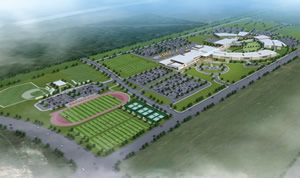The Educational Village
- By Irene Nigaglioni
- 09/01/16

IMAGE COURTESY OF THE EDUCATIONAL VILLAGE
As students head back to school this fall, we are reminded of the challenges that many will
face as part of their educational experience. The challenges
for many will be aggravated by old, outdated facilities
designed for a different era, and designed without consideration
for the health and wellbeing of its users. On average, a student
will spend over 13,000 hours in school, from grades K-12. The
school environments where they spend such a significant part of
their lives can have a substantial impact on their cognitive ability,
health and wellbeing.
Traditionally, due to explosive fast growth, the Cypress-Fairbanks Independent School District, a large suburban district
outside of Houston, Texas, had designed prototype schools in
multi-campus sites, many times with each school totally isolated
from the other. Given a slight slowdown due to the recession,
the district decided to rethink the way they designed and built
schools, and asked its cadre of architects to design schools driven
by the desired learning outcomes and protocols, but that were also
healthy and sustainable, meeting the requirements of the Texas
CHPS program. Armed with the research on the impact of healthy
and sustainable, interactive design on learning, and challenged
to design a healthier, happier place for students, we embraced the
task to design their new multi-campus site.
The new Cypress Park High School, is the first school to open
in the new educational village setting. This educational village will
eventually include an elementary school, middle school, shared
cafeteria/dining/community space, and a public, community health
clinic. Inspired by research that supports that green spaces in school
environments can have a range of health benefits for students as well
as improvement in cognitive development (Susan Hanson, Clark
University, Worcester, Mass., 2015) the new educational village
focuses on the careful development of the green space that is shared
by all the schools, and is the focus of the overall village design. This
green space creates an inviting outdoor setting for students, staff
and community, and expands the learning environment through
the use of glazing and vistas from all classrooms. This space was
carefully designed to maximize greenery, in order to provide for enhanced
opportunities for free play, exploration and discovery. These
green spaces are also designed to shield traffic noise and stress while
increasing opportunities for exercise.
The design of the new high school embraces the state’s new
mandate for a more rigorous secondary curriculum as outlined by
the new Foundation High School program, that includes the selection
of endorsements such as STEM, Business and Industry, Public
Services, Arts and Humanities, and Multi-Disciplinary for all
students entering the ninth grade. This underlying theme helped
with the organization of the school, as endorsements were stacked
in the three story facility creating connections for students as they
travel through the school on any given day. This also allowed the
design team to create diverse interactive settings throughout the
building, allowing for casual collisions to occur during the school
day. These diverse settings were further enhanced by the sustainable
and healthy features of the building, such as the three story
natural light shafts that introduce natural light in the heart of
the learning community wing, bringing warmth and calm to the
learning environment.
Other such sustainable features include the enhanced acoustical
ceiling and wall treatment of all shared spaces, allowing for
conversation, collaboration and discovery to thrive. Also, understanding
that our wellbeing and ability to learn is activated by
moments of surprise and delight, the curved design of the learning
communities allows for pockets of excitement to pop throughout
the travel from one end of the building to the other. These pockets
are further enhanced by natural light, and the introduction of
interactivity, both through the use of interactive energy management
displays and active learning furniture.
In learning environments, surprise, wonder and excitement
can take students’ focus away from the challenges and baggage
they may bring or carry from home. This sense of excitement can
lead to a healthier, more balanced and clear outlook on learning
and in the end, improve students’ cognitive ability. The new
Cypress Parks High School and Educational Village provide
the setting for learning to thrive, wonder to rule and health to
conquer.
This article originally appeared in the issue of .
About the Author
Irene Nigaglioni, AIA, ALEP, is a partner at PBK Architects Inc. and an active member of the Association for Learning Environments.